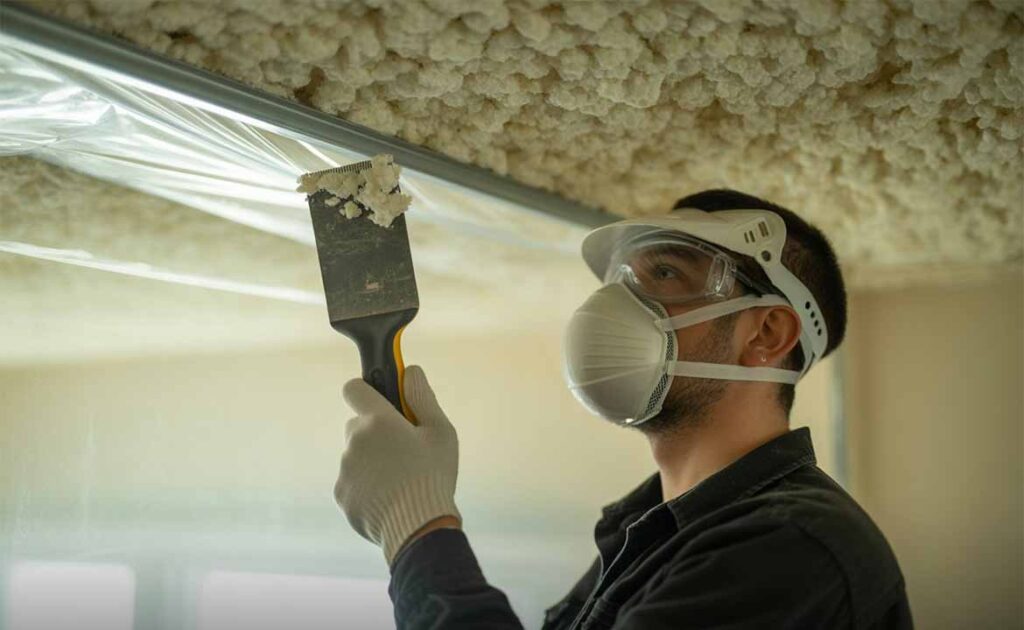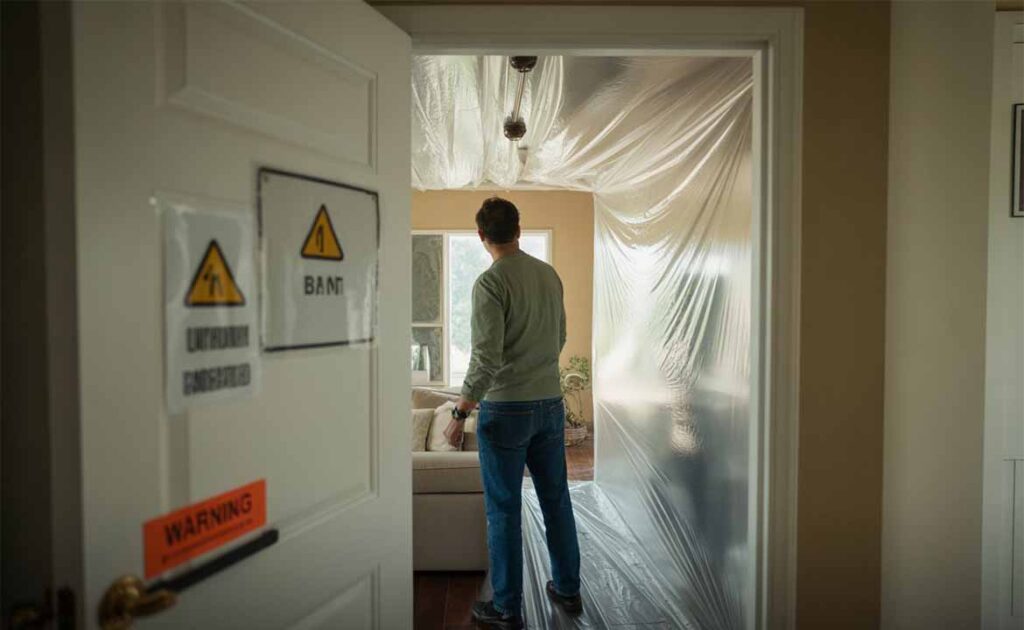Many American homes built between the 1950s and 1990s feature cottage cheese ceilings. These textured ceilings were popular because they hid imperfections and reduced noise. However, some of these ceilings contain asbestos in ceilings, a hazardous material that can cause serious health problems. Knowing the risks, testing methods, and removal options is essential for safe asbestos handling in your home. This guide will help you understand everything about cottage cheese ceilings asbestos.
Popcorn ceilings, another name for cottage cheese ceilings, are often linked with asbestos popcorn ceiling hazards. Homes built in the 1980s sometimes still used asbestos in ceiling textures. Understanding the history of these ceilings and the home ceiling asbestos risk will help you make safer decisions for your family.
What Are Cottage Cheese Ceilings?
Cottage cheese ceilings are textured ceilings with a bumpy, lumpy appearance. They are also called popcorn ceilings. Builders used them because they were cheap, hid cracks, and absorbed sound well. Many homes built before 1990 in the USA still have these ceilings. The texture can trap dust and allergens, adding to maintenance issues.
These ceilings became less popular after the dangers of asbestos in ceilings became widely known. Today, ceiling texture removal projects often include removing or encapsulating these old ceilings. Many homeowners consider DIY popcorn ceiling removal, but it is risky if asbestos is present. Licensed asbestos contractors are recommended for testing and safe removal.
Understanding Asbestos in Popcorn Ceilings
Cottage Cheese Ceilings Asbestos became a concern once people learned about asbestos’s harmful effects. Asbestos was added for fire resistance and durability, especially in popcorn ceilings. Inhaling the fibers causes severe diseases, including mesothelioma risk from asbestos and lung cancer.
Homes built before 1980 are the most likely to contain asbestos in ceilings. Understanding health risks of asbestos in ceilings helps homeowners take action. Professional removal and testing by experts keep Cottage Cheese Ceilings Asbestos from becoming a health hazard.
How to Identify Asbestos in Cottage Cheese Ceilings

Detecting Cottage Cheese Ceilings Asbestos isn’t easy without testing. The safest method is a popcorn ceiling asbestos test conducted by a professional. They collect samples safely without spreading fibers.
If your home was built before the 1980s, assume a risk. The likelihood of asbestos in cottage cheese ceilings is high in older buildings. Never start DIY popcorn ceiling removal without testing it can turn your ceiling into a home ceiling asbestos risk zone.
Common Symptoms of Asbestos Exposure
Exposure to Cottage Cheese Ceilings Asbestos can cause persistent coughing, shortness of breath, and chest tightness. These are early asbestos exposure symptoms. Prolonged exposure may lead to mesothelioma risk from asbestos and lung cancer.
If you notice these signs and have an old asbestos popcorn ceiling, see a doctor immediately. Catching asbestos in ceilings issues early can prevent serious illness. Protecting yourself from Cottage Cheese Ceilings Asbestos starts with awareness and testing.
Likelihood of Asbestos in Your Ceiling
The likelihood of asbestos in cottage cheese ceilings depends on your home’s age. Houses built before 1980 are the most likely to contain Cottage Cheese Ceilings Asbestos. Homes built after 1990 are generally safer, but testing remains important.
The best protection is professional inspection. A popcorn ceiling asbestos test reveals whether you need asbestos ceiling removal or encapsulating asbestos ceilings. Understanding Cottage Cheese Ceilings Asbestos risks keeps your family safe.
Safe Removal of Asbestos Popcorn Ceilings

When dealing with Cottage Cheese Ceilings Asbestos, never attempt DIY popcorn ceiling removal. Only licensed asbestos contractors have the equipment and training to do it safely. They use containment systems, masks, and filters to prevent fiber spread.
Another safe option is encapsulating asbestos ceilings, sealing fibers beneath a new layer of paint or drywall. This reduces the home ceiling asbestos risk without removing the material. Professional safe asbestos handling is always recommended for Cottage Cheese Ceilings Asbestos.
Costs Associated with Asbestos Ceiling Removal
The ceiling asbestos removal cost for Cottage Cheese Ceilings Asbestos depends on size and condition. On average, full removal costs $3–$7 per square foot, while encapsulation costs $1–$3. Hiring professionals ensures safe asbestos handling and compliance with U.S. safety laws.
| Method | Cost per sq ft | Notes |
|---|---|---|
| Full Removal | $3–$7 | Recommended for damaged ceilings |
| Encapsulation | $1–$3 | Seals fibers without removal |
| DIY (Not recommended) | Varies | High home ceiling asbestos risk |
Accidental Removal or Damage – What to Do
If you accidentally removed asbestos popcorn ceiling, stop immediately. Evacuate the area and avoid contact with dust. Contact licensed asbestos contractors for cleanup. Even minor disturbance increases home ceiling asbestos risk.
Proper containment and cleanup prevent asbestos exposure symptoms. Never attempt DIY popcorn ceiling removal after accidental damage, as it can release dangerous fibers from cottage cheese ceilings asbestos.
Alternatives to Removing Cottage Cheese Ceilings

Instead of removing cottage cheese ceilings asbestos, homeowners can choose encapsulating asbestos ceilings, sealing fibers without full removal. Covering with drywall or modern textures hides old popcorn ceilings and lowers home ceiling asbestos risk.
This approach is safer and cost-effective. Cosmetic updates combined with encapsulation prevent fiber exposure while improving aesthetics. Always hire professionals for testing and handling asbestos in ceilings to keep your home safe.
FAQs
Do cottage cheese ceilings have asbestos?
Some cottage cheese ceilings installed before the 1980s or early 1990s may contain asbestos in ceilings, but not all do.
Do stippled ceilings have asbestos?
Stippled or textured ceilings sometimes contain asbestos popcorn ceiling, especially in older homes built before 1980.
Is it safe to live in a house with asbestos ceilings?
Yes, if the ceilings are undisturbed; fibers are only dangerous when damaged or removed improperly.
How can you tell if a ceiling has asbestos?
The safest way is a popcorn ceiling asbestos test conducted by licensed asbestos contractors.
Can I test my ceiling for asbestos?
Yes, but professional testing is recommended for safe asbestos handling; DIY testing can be risky.
What are the early symptoms of asbestos exposure?
Early signs include coughing, shortness of breath, chest pain, and irritation of the eyes or throat, all known asbestos exposure symptoms.

